-
Paper Information
- Paper Submission
-
Journal Information
- About This Journal
- Editorial Board
- Current Issue
- Archive
- Author Guidelines
- Contact Us
International Journal of Energy Engineering
p-ISSN: 2163-1891 e-ISSN: 2163-1905
2015; 5(2): 25-33
doi:10.5923/j.ijee.20150502.02
Evaluation of Electric Energy Losses in Southern Governorates of Jordan Distribution Electric System
Oda Refou, Qais Alsafasfeh, Mohammed Alsoud
Electrical Engineering Department, Tafila Technical University
Correspondence to: Qais Alsafasfeh, Electrical Engineering Department, Tafila Technical University.
| Email: |  |
Copyright © 2015 Scientific & Academic Publishing. All Rights Reserved.
Losses incurred in electrical power systems have two components: technical losses and non-technical losses. This paper, presents the results of a practical case study for assessing both technical and non-technical losses of a transmission and distribution network at Southern Governorates of Jordan Distribution Electric System and appropriate solutions and suggestions to reduce the losses. There are two proposed methods that can be used to calculate technical energy losses, a method based on subtraction of metered energy purchased and metered energy sold to customers by review the load curve, field survey, and data record this method will be presented in this paper, the second method based on modeling losses in individual components of the system will present in future work.
Keywords: Non-technical losses, Technical losses, Distribution system and electrical watt meter
Cite this paper: Oda Refou, Qais Alsafasfeh, Mohammed Alsoud, Evaluation of Electric Energy Losses in Southern Governorates of Jordan Distribution Electric System, International Journal of Energy Engineering, Vol. 5 No. 2, 2015, pp. 25-33. doi: 10.5923/j.ijee.20150502.02.
Article Outline
1. Introduction
- The electrical percentage loss is counted as a difference between amount of purchased electrical energy by electricity distribution company (it is recorded at the first day of every month) and amount of sold electrical energy which is consumed by customers (it is taken from watt-hour meter of customers every month).
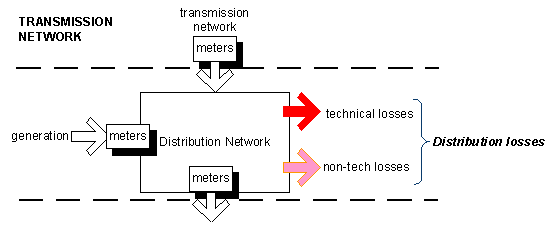 There are two types of counted electrical loss.• Technical losses in cables and transformers at medium and low voltage which proportional to square of load current.• Non-technical losses which are due to error of watt-hour meter and illegal use of electrical energy by customers.The former are related with problems in the system through the physical characteristics of the equipment, that is, the technical losses are the energy lost in the transport, the transformation and the equipment of measurement, becoming a very high cost to the electric power companies. The commercial losses or non-technical losses are those associated with the commercialization of the supplied energy to the user and refer to the delivered and not billed energy, propitiating a loss in the profits depending on a utility’s size and network, generally between % 12-7 of the electricity produced at the generation site is lost between the generation facilities and the end users [2] also by reducing both technical and nontechnical electrical losses the efficiency of electrical power system will be increased [3, 4]. A methodology to refine the technical losses calculation from estimates of non-technical losses was presented in [5].In [6] present mathematical analysis of losses that occur in electric power system. The Depezo loss formula, loss factor, use of system parameters for evaluating the system losses, the differential power loss and power flow methods are explicitly illustrated. The B-losses coefficient, which expresses the transmission losses as a function of outputs of all generation, in [7] the effects of meshed distribution system operation on network electrical losses, within the Capacity to Customers was presented also the losses have been computed for the circuits in configurations where the Normally Open Point is in both open and closed positions. New method for the computation of technical losses in electrical power distribution systems based on determines technical losses in specific networks in a hierarchicalway [8], an adaptive hybrid genetic algorithm was used for technical loss reduction in distribution networks under variable demands [9], in other research technical loss computation will help to solve and predict economic dispatch model for T&D [10], in [11] Energy Losses Estimation based on the “loss coefficient” as the fundamental parameter for describing load variations in loss estimation. Technical losses depend on physical characteristics of the system so some researcher present non-technical losses in [12] proposed an innovative and accurate solution for non-technical losses identification using the Optimum-Path Forest (OPF) classifier and its learning algorithm also in [13] present a state estimation based approach for distribution transformer load estimation is exploited to detect meter malfunction/tampering and provide quantitative evidences of non-technical loss.The aim of this paper is to apply an approach based on technical and reliability requirements, economic considerations of costs of energy loss and expansion of system to meet the growth of prospective demand with least cost. Concluded from investigation of the nature to non- technical losses in power systems, their sources, the measurement of non-technical losses, some measures to reduce them, and possibly their impact on the system.
There are two types of counted electrical loss.• Technical losses in cables and transformers at medium and low voltage which proportional to square of load current.• Non-technical losses which are due to error of watt-hour meter and illegal use of electrical energy by customers.The former are related with problems in the system through the physical characteristics of the equipment, that is, the technical losses are the energy lost in the transport, the transformation and the equipment of measurement, becoming a very high cost to the electric power companies. The commercial losses or non-technical losses are those associated with the commercialization of the supplied energy to the user and refer to the delivered and not billed energy, propitiating a loss in the profits depending on a utility’s size and network, generally between % 12-7 of the electricity produced at the generation site is lost between the generation facilities and the end users [2] also by reducing both technical and nontechnical electrical losses the efficiency of electrical power system will be increased [3, 4]. A methodology to refine the technical losses calculation from estimates of non-technical losses was presented in [5].In [6] present mathematical analysis of losses that occur in electric power system. The Depezo loss formula, loss factor, use of system parameters for evaluating the system losses, the differential power loss and power flow methods are explicitly illustrated. The B-losses coefficient, which expresses the transmission losses as a function of outputs of all generation, in [7] the effects of meshed distribution system operation on network electrical losses, within the Capacity to Customers was presented also the losses have been computed for the circuits in configurations where the Normally Open Point is in both open and closed positions. New method for the computation of technical losses in electrical power distribution systems based on determines technical losses in specific networks in a hierarchicalway [8], an adaptive hybrid genetic algorithm was used for technical loss reduction in distribution networks under variable demands [9], in other research technical loss computation will help to solve and predict economic dispatch model for T&D [10], in [11] Energy Losses Estimation based on the “loss coefficient” as the fundamental parameter for describing load variations in loss estimation. Technical losses depend on physical characteristics of the system so some researcher present non-technical losses in [12] proposed an innovative and accurate solution for non-technical losses identification using the Optimum-Path Forest (OPF) classifier and its learning algorithm also in [13] present a state estimation based approach for distribution transformer load estimation is exploited to detect meter malfunction/tampering and provide quantitative evidences of non-technical loss.The aim of this paper is to apply an approach based on technical and reliability requirements, economic considerations of costs of energy loss and expansion of system to meet the growth of prospective demand with least cost. Concluded from investigation of the nature to non- technical losses in power systems, their sources, the measurement of non-technical losses, some measures to reduce them, and possibly their impact on the system.2. Methodology
- A combination of methodologies is applied in this project to address the objectives. A summarised overview list of explicit methodologies for various specific objectives: specified in the previous section are provided in Fig.1 with a brief descriptions in subsections below.
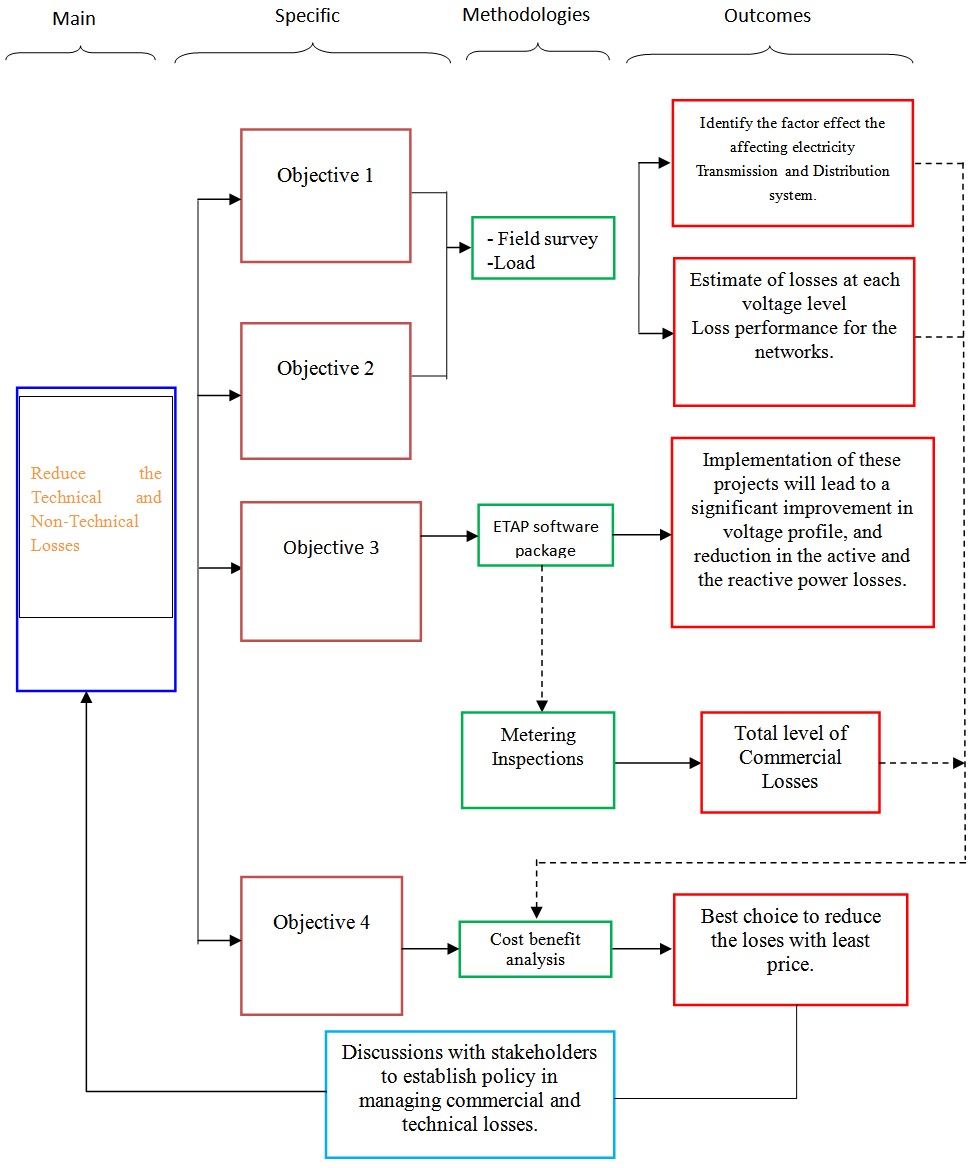 | Figure 1. Methodology Energy Losses |
3. Distribution Electric System of Southern Governorates in Jordan
- Distribution electric system of southern governorates in Jordan cover four governorates (Ma'an Aqaba, Tafila and Karak), the total number of constructed substations and their accumulative capacity in the distribution areas lha1 belong to the company until the end of 2013 was (4531) with a capacity of 2542 MVA, at the end of 2013, the total length of medium and low voltage for both overhead and underground networks have been reached (11650) km [1].
4. Results and Evaluation of Electric Energy Losses
- Overall losses at 2013 of all southern Governorates of Jordan Distribution Electric System (Ma'an, Aqaba, Tafila and Karak) was shown in Fig.2 the max losses in Ma’an and the lowest at Karak.
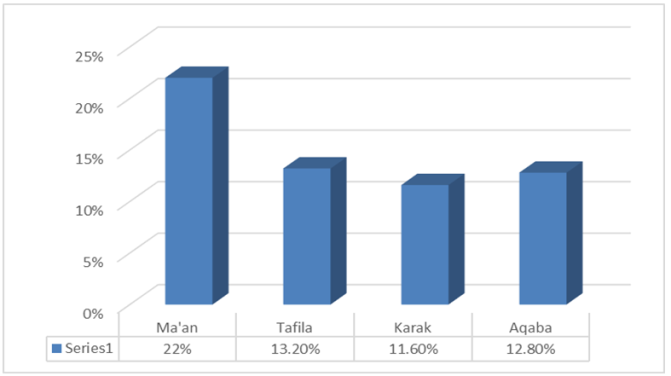 | Figure 2. Overall losses at 2013 of all southern Governorates of Jordan |
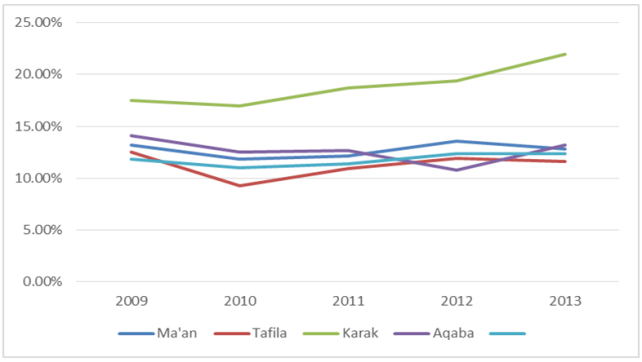 | Figure 3. Over all Electrical percentage losses in all governorates' of Jordan at the period of 2009-2013 |
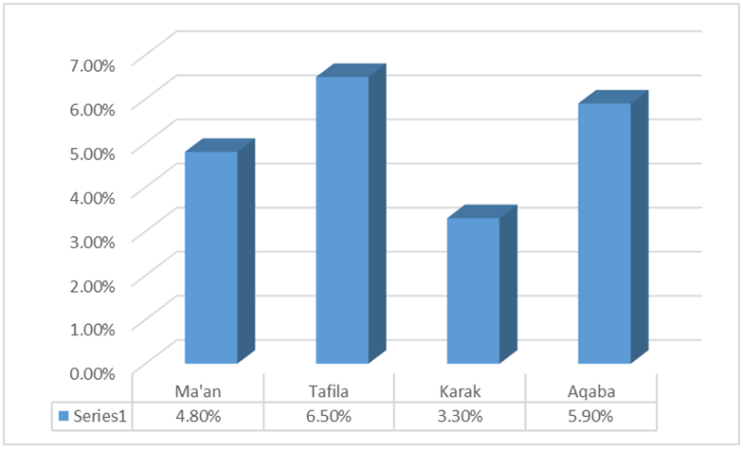 | Figure 4. Electrical losses at medium voltage in 2013 |
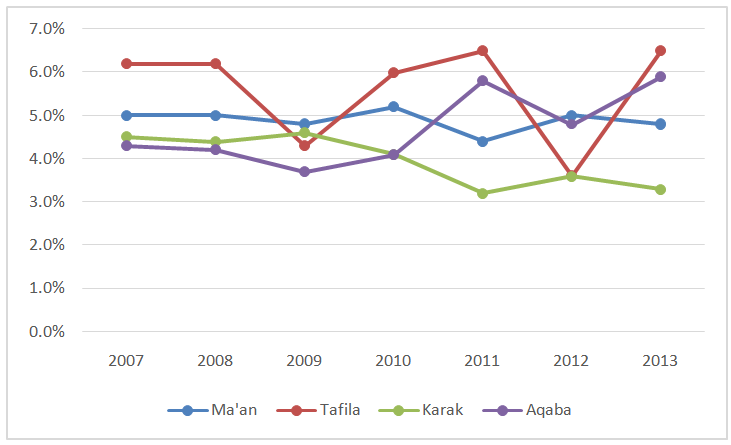 | Figure 5. Electrical losses at medium voltage in the period of (2007-2013) |
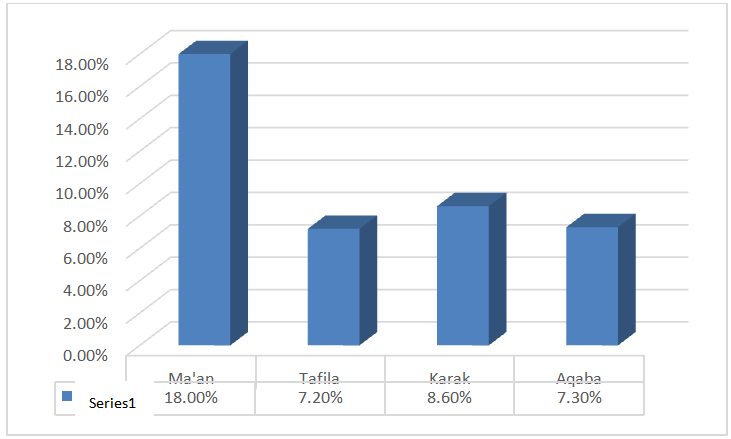 | Figure 6. Electrical losses at low voltage in 2013 |
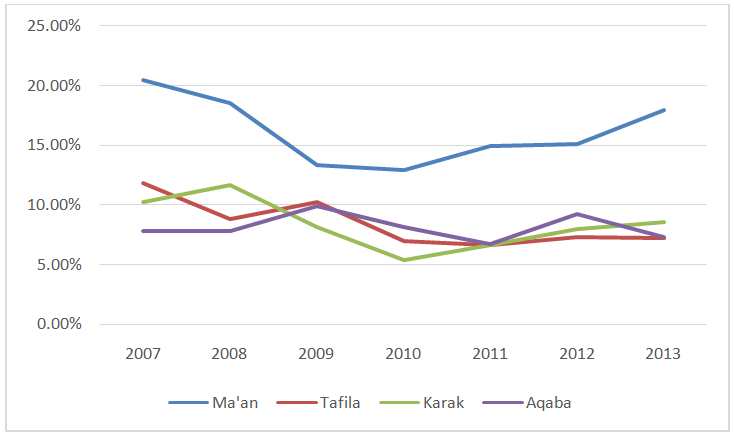 | Figure 7. Electrical losses at low voltage in the period of (2007-2013) |
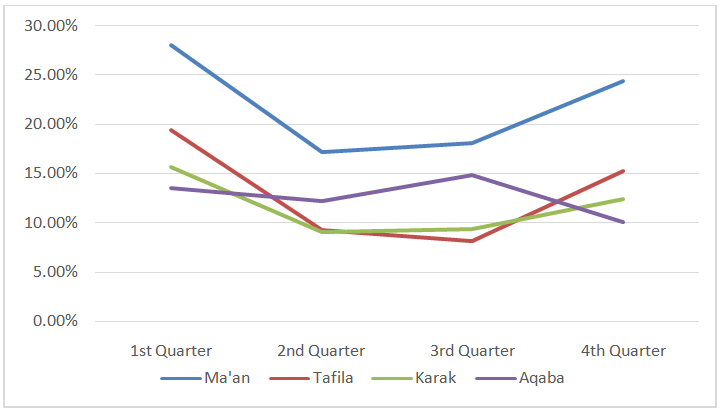 | Figure 8. Electrical losses in quarter bases of 2013 |
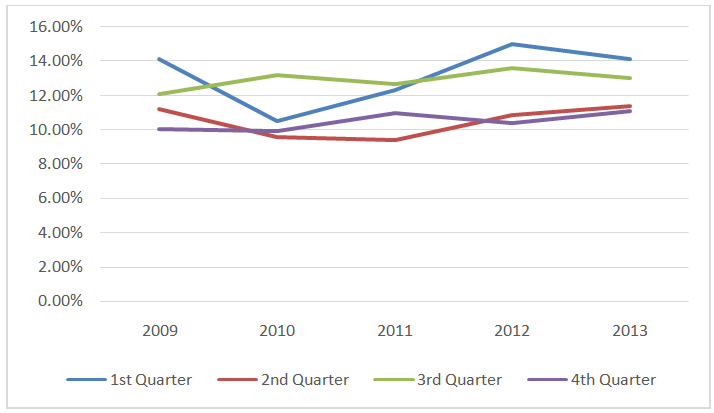 | Figure 9. Total percentage losses of electrical energy in quarter bases of period (2009-2013) |
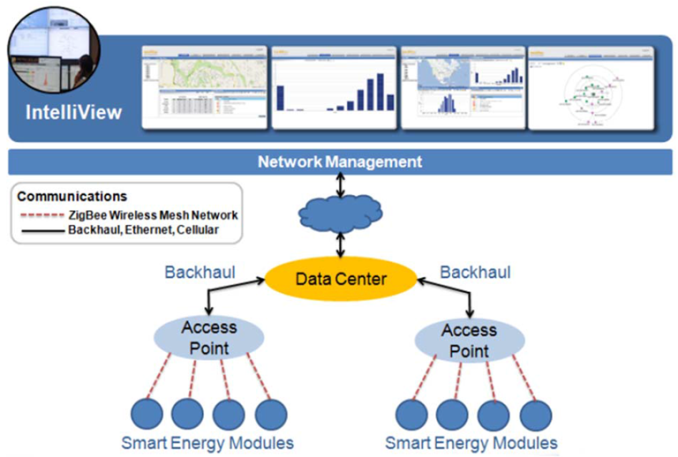 | Figure 10. Smart Grids Solution for Technical Losses Reduction |
5. Analysis
- Electrical percentage losses was increased in 2012 up to 12.4% in compare with 11.4% in 2011 in all southern governorates of Jordan except Tafila, in 2013 the percentage still almost the same of 2012 the reasons of increasing are:• Decline in demand of big consumer specially in Aqaba.• Decreasing the detected cases due to illegal usage of electrical energy from 26Ghw in 2011 to 20Ghw in 2012, this shared in increasing the electrical losses.• Increasing the detected cases due to illegal usage of electrical energy from 22Ghw in 2012 to 27Ghw in 2013, this shared in decreasing the electrical losses.• At low voltage the increasing of percentage losses was 7.2% in 2011 in compare with 8.3% in 2012 for all the southern governorates and areas of Jordan.• The actions for detecting the energy theft were resisted by customers.• These actions were, field inspection testes of loads in distributed panel and on consumers meters, training courses.• New technology and new electronic devices and meter should be used to avoid the bad behavior.• Growth in purchased electrical energy in all southern governorates of Jordan which reached 6.7% in 2012 comparing it with 2011 of Jordan, the growths were, ma'an 7%, Tafila 6.8%, Aqaba 6% and Karka 2.3%.• Adjustment of tariff was done twice on 29/5/2012 and on 5/6/2012 and once on 2013/8/15 the prices ricing (new tariff) led to more cases of energy theft.
6. Recommendations
- For the purpose of reduction the electrical losses it is recommended to do the following actions:• In governorate of Aqaba, watt-meter readings and reports of losses should be send to the planning department to determine the reasons of losses.• Continue to implement the five-year plan which aims to improve the performance of all the company especially to reduce the losses.• Enter all the information of customers in the monthly invoice consumption, especially those new costumers after the erections new watt-meters for private and public sectors and preparing the readings monthly.• Count the numbers of all watt-meters in areas and follow up the taken actions by administration and electricians.• One year planning for inspection and testing for all the meters twice per year for the big consumers.• One test for watt-meters domestic use at low voltage per three years.• Measuring electrical loads at substations and feeder at peak load in summer and winter day and night, this action will help as follow:− Installation new feeders and watt-meter to overcome overload case.− Increase electrical capacity if it is loaded up to 80% of its rate.− Redistribute the load between phases to achieve load balancing.− Make a comparison between the electrical load of substation and the consumed load according the reading of watt-meters to detect the faulty case or illegal use of energy.− Depending on measurements of load and voltage, actions should be taken to avoid the drop voltage and its bad fluencies.• Forming technical committees to check the documented electrical drawing and connections to confirm it with the site connections and installation, this action will help as follow:− Correct faulty cases.− Check the electrical drawings.− Insure that all the substation, feeder are involved in electrical diagrams.− Readings of substation compatible with watt-meters reading at consumer side− Check the name-plates of transformers in site and in drawing and confirm it.− Reinsulate and joint injured cables and wires.− After the installation new electronic watt-meters, reevaluate the influences of these device on electrical losses.• Make periodic test to detect illegal connection of power supply and to stop the energy theft.• Follow up the tracking of cables from substation to the feeders and distributed panels to detect misuse in electricity• Measure the load at substation side and at the consumer’s side and make a comparison between then to detect the difference and take action.• The illegal use should be estimated accurately if there is no correct estimation the energy theft will increase.• Theft of energy should be announced to take care from these cases.• Don’t estimate and issue successive invoices.• Sample test should be done to insure the accuracy of these devices.• Check the watt-meters of street-lighting.
7. Smart Grids Solution for Energy Losses Reduction
- Smart Grid technology can overcome technical losses by providing digital tools and processes that allow for a high degree of granularity in data accessibility and system control. Monitoring, command and control of the Distribution systems and the smart grid network are achieved via the Smart Energy Platform (IntelliView™). The Smart Energy Platform comprises two main functional modules. The Energy Management System (EMS) module enables the user to access energy generation data via a secure web browser in the system owner’s operations center. Similarly, the Network Management System (NMS) module enables communications network management and control from the operations center. The Smart Energy Platform collects and stores the Distribution system telemetry and enables access by authorized personnel from a web‐based graphical user interface (GUI). In addition, the system provides the command console used for transmitting configuration commands to the Distribution systems and Communicator.The scope of the overall project is to deploy smart solar systems on the roofs of electricity network subscribers across the Southern Governorates. The deployed systems would generate electric power, thus offsetting a good percentage of up‐to‐date electricity needs in Southern Governorates. The smart grid communication system also provides utilities with grid reliability tools by constantly monitoring and providing real‐time status updates on critical operating parameters such as voltage and frequency, thereby supporting automatic power outage detection and faster repair response time.
8. Conclusions
- Different methods can be used to compute the value of technical losses dissipated in the electrical power system depending on the situation and purpose. This paper, presents the results of a practical case study for assessing both technical and non-technical losses of a transmission and distribution network at Southern Governorates of Jordan Distribution Electric Systemcalculate technical energy losses, all losses calculated based on subtraction of metered energy purchased and metered energy sold to customers by review the load curve, field survey, and data record, list of recommendation are presented based on losses results also future solution also presented in this paper by using smart grid concept for energy losses reduction.
 Abstract
Abstract Reference
Reference Full-Text PDF
Full-Text PDF Full-text HTML
Full-text HTML